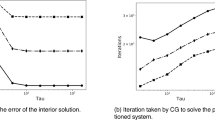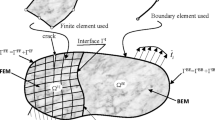Abstract
In this hybrid method, we consider Trefftz elements where the governing equations of equilibrium are required to be satisfied a-priori within the subdomain elements of some triangulation of the domain. If the Trefftz elements are modelled with boundary potentials supported by the individual element boundaries, this defines the so-called macro-elements which allow one to handle particular situations involving singular features such as cracks, inclusions, corners, and notches, and which provide locally high resolution of the desired stress field, in combination with a global variational FEM analysis. The bandwidth of the global stiffness matrix is smaller than the one in conventional hybrid FEM methods. In addition, with slight modifications, the macro-elements can be incorporated into standard commercial FEM codes. The coupling between the elements is modelled by using a generalized compatibility condition in a weak sense which allows to relax the continuity requirements for the global displacement field. As a consequence, the mesh points of the macro-elements can be chosen independently of the nodes of the FEM structure. In particular, this formulation provides the possibility of combining independent meshes and also exploiting modern parallel computing facilities. In this lecture we present the formulation, functional analytic setting, asymptotic error estimates and some numerical results.
Access this chapter
Tax calculation will be finalised at checkout
Purchases are for personal use only
Preview
Unable to display preview. Download preview PDF.
Similar content being viewed by others
References
E. Schnack, A hybrid BEM-model. Int. J. Num. Engng. Vol.5 (1987) pp. 1015–1025.
G.C. Hsiao, E. Schnack and W.L. Wendland, A hybrid coupled finite-boundary element method. In preparation.
I. Becker, R. Carmine, N. Karaosmanoglu and E. Schnack, Two- and three-dimensional coupling of FEM and BEM in elasticity. In: Proc. of the European Boundary Element Meeting (EBEM) (ed: J.L. Migeot), Université de Bruxelles (1988) pp. 1.93–1.103.
K. Türke, A two grid method for coupling FEM and BEM, Doctoral Thesis, Karlsruhe University, Germany (1995).
Author information
Authors and Affiliations
Editor information
Editors and Affiliations
Rights and permissions
Copyright information
© 1995 Springer-Verlag Berlin Heidelberg
About this paper
Cite this paper
Hsiao, G.C., Schnack, E., Wendland, W.L. (1995). On Hybrid Coupled FEM-BEM Stress Analyses. In: Atluri, S.N., Yagawa, G., Cruse, T. (eds) Computational Mechanics ’95. Springer, Berlin, Heidelberg. https://doi.org/10.1007/978-3-642-79654-8_453
Download citation
DOI: https://doi.org/10.1007/978-3-642-79654-8_453
Publisher Name: Springer, Berlin, Heidelberg
Print ISBN: 978-3-642-79656-2
Online ISBN: 978-3-642-79654-8
eBook Packages: Springer Book Archive




